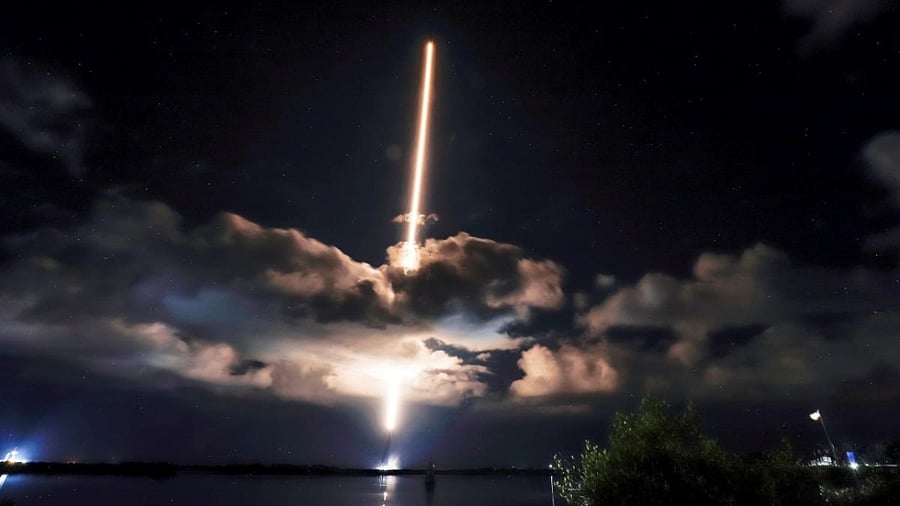
Representational image for a spacecraft.
Credit: Reuters Photo
The history of warfare also shows that war has long seen heavy investments in the form of innovation, human cost, and development of weapons. Advancements in weaponry by forgers of steel, and strategy, enabled the three-dimensional orchestration of war. Since World War I, humanity has seen war fighting change from land-based battles to those fought across air and sea. The rise of artificial intelligence (AI) as a strategic tool represents one of the most significant challenges in space governance and modern warfare.
Outer space is increasingly recognised as vital for data, health, climate change, energy, and, most significantly, national security. In 2019, NATO adopted an Overarching Space Policy and declared space an operational domain, alongside air, land, maritime, and cyberspace. It is not just NATO; countries have also started establishing space forces in line with their army, navy, and air force. The rise of these emerging technologies is reshaping the interpretation of existing space treaties.
At the operational level, space technologies were essentially used to assist land, air and naval forces in their warfighting capabilities. However, space technologies remain vulnerable to both kinetic and non-kinetic attacks, ranging from anti-satellite weapons to jamming, spoofing, etc.
The synergy of AI and space technologies benefits in drawing predictive data patterns for disaster management, climate change, resource mining, etc. However, AI in space is also used for surveillance, navigation, and developing autonomy in weapons and warfare.
India’s defence budget has risen from ₹2.53 trillion in FY2014 to ₹6.81 trillion in FY2025-26. In space tech, the Cabinet Committee on Security approved the ₹26,968-crore Phase 3 of the Space-Based Surveillance programme in 2024, which includes the launch of 52 surveillance satellites. Out of which 31 will be launched by three private Indian companies, and 21 will be built and launched by ISRO. Most venture capital firms avoid direct investment in weapons contracts due to national security restrictions. However, they often invest in startups whose military innovations can be repurposed for civilian applications. The unprecedented investments in AI and computing raise concerns about surrogate investments in the defence sector.
In the space race era, the space sector was demarcated into military, civil, and commercial domains. With the unprecedented investments and technological developments in the space sector, the existing boundaries of the use of space have blurred. For example, launch vehicles, small satellites, and active debris removal systems procured for civilian use could be (re)programmed for military use and then channelled for weaponisation. It also renews the call for drafting national space laws, especially in countries like India, which have kept space governance outside the legislative regulatory mechanism. India’s space sector has been advancing dual-use capabilities, the best example is the Indian Regional Navigation Satellite System, which provides navigation services to civilians, defence forces, and various sectors of the economy.
India’s dual-use space tech also helps maritime surveillance, communication, navigation, and electronic warfare. After India’s anti-satellite tests in 2019, ISRO launched Project NETRA to monitor and protect critical space assets. AI in India’s space sector is significantly changing how space military technologies, situational awareness, and sensor networks can facilitate autonomous decision-making.
At the policy level, it also calls for the integration of import and export regulations on dual-use products, stronger regulations around arms control and verification regimes. The integration of critical technologies, like deep-learning models and autonomous dual-use capabilities, has forced space organisations to substantially invest in AI innovation. The rise in investments in this sector also requires careful interrogation regarding security and ethics, underscoring the complexity and risks inherent in governing their use.
Article IV of the 1967 Outer Space Treaty (OST) stipulates: ‘States Parties…undertake not to place in orbit around the earth any objects carrying nuclear weapons or any other kinds of weapons of mass destruction (WMD), install such weapons on celestial bodies, or station such weapons in outer space.’ However, Article IV has been subject to polysemic interpretations and strategic deviations. In its hermeneutic plurality, one interpretation maintains that it only prohibits the placement and installation of such weapons, but not their testing. While another limits its scope strictly to nuclear weapons and WMDs, leaving contemporary non-WMD technologies outside its purview.
The contested interpretation of OST exposes the inadequacy and toothlessness of international space laws in dealing with modern military capabilities. In the absence of international laws, national space laws must build trust in space technologies. India must draft a national space law to reimagine a multi-faceted governance approach and rethink its space governance structure, institutions, and systems in the AI era.
(Adithya Variath is Assistant Professor, Jindal Global Law School, and Fellow, Centre for International Legal Studies, O P Jindal Global University.)
(Disclaimer: The views expressed above are the author's own. They do not necessarily reflect the views of DH.)